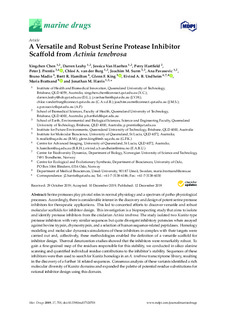| dc.contributor.author | Chen, Xingchen | |
| dc.contributor.author | Leahy, Darren | |
| dc.contributor.author | Van Haeften, Jessica | |
| dc.contributor.author | Hartfield, Perry | |
| dc.contributor.author | Prentis, Peter J. | |
| dc.contributor.author | van der Burg, Chloé | |
| dc.contributor.author | Surm, Joachim M. | |
| dc.contributor.author | Pavasovic, Ana | |
| dc.contributor.author | Madio, Bruno | |
| dc.contributor.author | Hamilton, Brett R. | |
| dc.contributor.author | King, Glenn F. | |
| dc.contributor.author | Undheim, Eivind Andreas Baste | |
| dc.contributor.author | Brattsand, Maria | |
| dc.contributor.author | Harris, Jonathan M. | |
| dc.date.accessioned | 2020-02-17T16:15:34Z | |
| dc.date.available | 2020-02-17T16:15:34Z | |
| dc.date.created | 2020-01-14T08:38:48Z | |
| dc.date.issued | 2019 | |
| dc.identifier.citation | Marine Drugs. 2019, 17 (701), 1-21. | nb_NO |
| dc.identifier.issn | 1660-3397 | |
| dc.identifier.uri | http://hdl.handle.net/11250/2642090 | |
| dc.description.abstract | Serine proteases play pivotal roles in normal physiology and a spectrum of patho-physiological processes. Accordingly, there is considerable interest in the discovery and design of potent serine protease inhibitors for therapeutic applications. This led to concerted efforts to discover versatile and robust molecular scaffolds for inhibitor design. This investigation is a bioprospecting study that aims to isolate and identify protease inhibitors from the cnidarian Actinia tenebrosa. The study isolated two Kunitz-type protease inhibitors with very similar sequences but quite divergent inhibitory potencies when assayed against bovine trypsin, chymostrypsin, and a selection of human sequence-related peptidases. Homology modeling and molecular dynamics simulations of these inhibitors in complex with their targets were carried out and, collectively, these methodologies enabled the definition of a versatile scaffold for inhibitor design. Thermal denaturation studies showed that the inhibitors were remarkably robust. To gain a fine-grained map of the residues responsible for this stability, we conducted in silico alanine scanning and quantified individual residue contributions to the inhibitor’s stability. Sequences of these inhibitors were then used to search for Kunitz homologs in an A. tenebrosa transcriptome library, resulting in the discovery of a further 14 related sequences. Consensus analysis of these variants identified a rich molecular diversity of Kunitz domains and expanded the palette of potential residue substitutions for rational inhibitor design using this domain. | nb_NO |
| dc.language.iso | eng | nb_NO |
| dc.publisher | MDPI | nb_NO |
| dc.rights | Navngivelse 4.0 Internasjonal | * |
| dc.rights.uri | http://creativecommons.org/licenses/by/4.0/deed.no | * |
| dc.title | A Versatile and Robust Serine Protease Inhibitor Scaffold from Actinia tenebrosa | nb_NO |
| dc.type | Journal article | nb_NO |
| dc.type | Peer reviewed | nb_NO |
| dc.description.version | publishedVersion | nb_NO |
| dc.source.pagenumber | 1-21 | nb_NO |
| dc.source.volume | 17 | nb_NO |
| dc.source.journal | Marine Drugs | nb_NO |
| dc.source.issue | 701 | nb_NO |
| dc.identifier.doi | 10.3390/md17120701 | |
| dc.identifier.cristin | 1771957 | |
| dc.description.localcode | © 2019 by the authors. Licensee MDPI, Basel, Switzerland. This article is an open accessarticle distributed under the terms and conditions of the Creative Commons Attribution(CC BY) license (http://creativecommons.org/licenses/by/4.0/). | nb_NO |
| cristin.unitcode | 194,66,10,0 | |
| cristin.unitname | Institutt for biologi | |
| cristin.ispublished | true | |
| cristin.fulltext | original | |
| cristin.qualitycode | 1 | |

